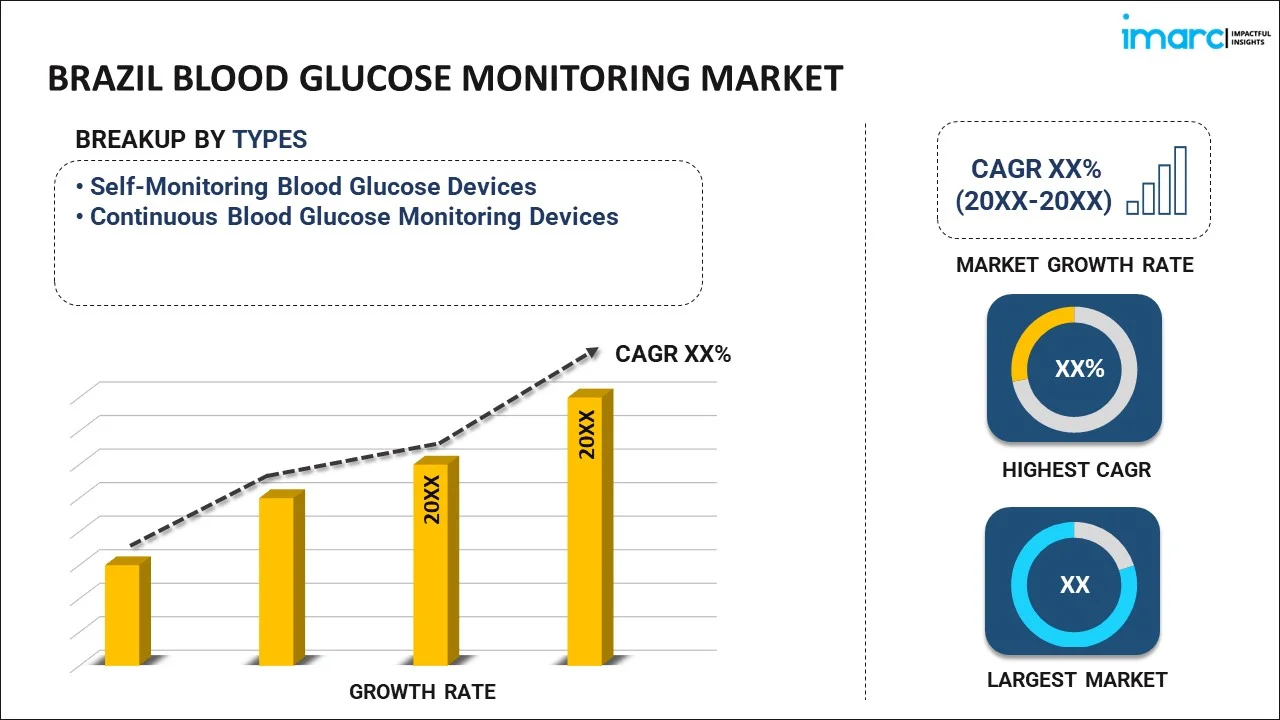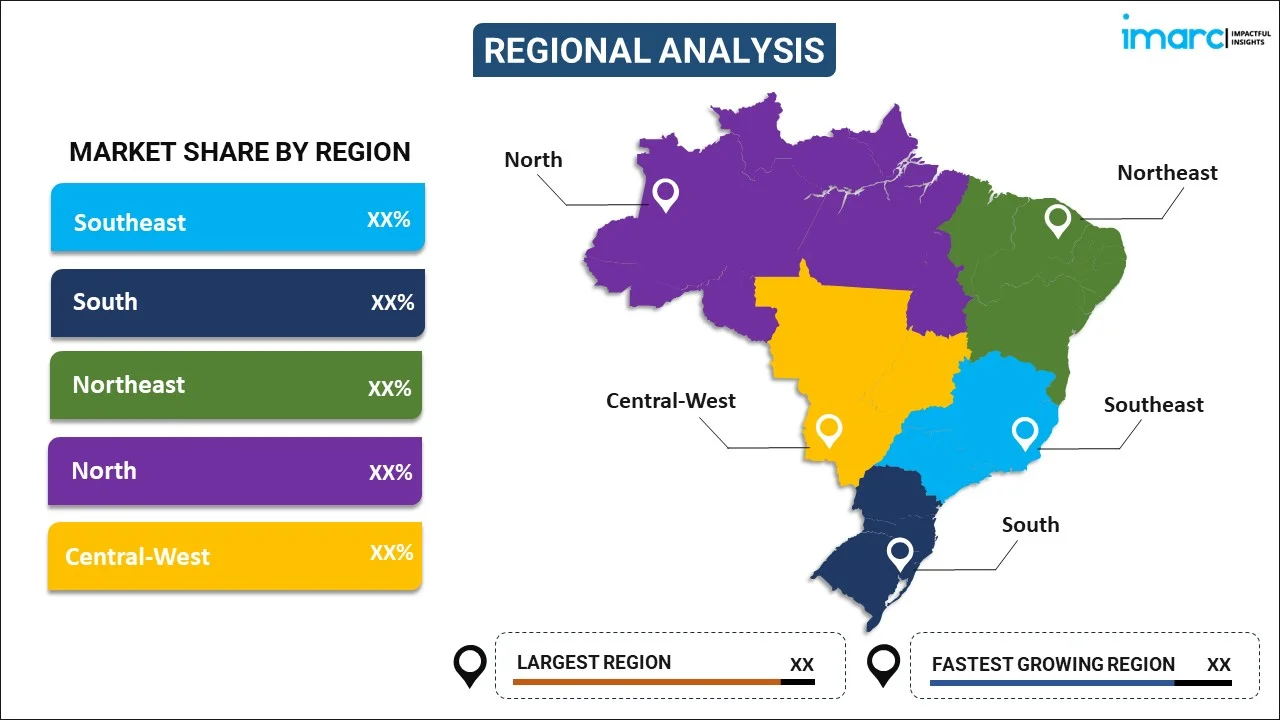
Brazil Blood Glucose Monitoring Market Report by Type (Self-Monitoring Blood Glucose Devices, Continuous Blood Glucose Monitoring Devices), and Region 2026-2034
Market Overview:
Brazil blood glucose monitoring market size reached USD 358.0 Million in 2025. Looking forward, IMARC Group expects the market to reach USD 630.4 Million by 2034, exhibiting a growth rate (CAGR) of 6.49% during 2026-2034. The increasing prevalence of diabetes, rising awareness about the importance of diabetes management, significant technological advancements, increasing aging population, rapid urbanization and changing lifestyles, and patient convenience offered by the device represent some of the key factors driving the market.
|
Report Attribute
|
Key Statistics
|
|---|---|
|
Base Year
|
2025
|
|
Forecast Years
|
2026-2034
|
|
Historical Years
|
2020-2025
|
|
Market Size in 2025
|
USD 358.0 Million |
|
Market Forecast in 2034
|
USD 630.4 Million |
| Market Growth Rate 2026-2034 | 6.49% |
Blood glucose monitoring involves the regular measurement of blood sugar levels to gauge how effectively the body is managing glucose, a crucial energy source derived from carbohydrates. This process is essential in helping individuals maintain stable blood sugar levels and make informed decisions about their diet, medication, and lifestyle. This is a vital practice in healthcare, particularly for individuals with diabetes. The procedure typically requires a blood glucose meter, lancet device, and test strips. A small drop of blood, often obtained from a fingertip, is placed on the test strip and inserted into the meter. The device then calculates and displays the blood sugar level, usually in milligrams per deciliter (mg/dL) or millimoles per liter (mmol/L), within a matter of seconds. Glucose monitoring is done various times throughout the day, such as before and after meals, exercise, or at bedtime, providing valuable insights into how different factors impact blood sugar.
Brazil Blood Glucose Monitoring Market Trends:
Brazil has witnessed a significant increase in the prevalence of diabetes over the years. The growing diabetic population has escalated the demand for blood glucose monitoring devices and supplies. Additionally, the increased awareness about the importance of diabetes management and monitoring among patients and healthcare professionals has resulted in higher adoption rates of blood glucose monitoring devices. Other than this, the availability of healthcare infrastructure, including hospitals and clinics, influences the accessibility and usage of blood glucose monitoring devices. Besides this, Brazil, like many other countries, has an expanding aging population. Older individuals are more prone to diabetes, which contributes to the demand for monitoring solutions. In line with this, rapid urbanization and changing lifestyles have led to a rise in sedentary behavior and poor dietary habits, contributing to the growing instances of diabetes cases. Furthermore, economic stability and inflating disposable income levels in Brazil influence the purchasing power of individuals, affecting their ability to invest in blood glucose monitoring devices. Apart from these factors, the extent of health insurance coverage for diabetes management impacts the affordability of monitoring equipment and supplies for patients. Moreover, devices that offer ease of use, such as continuous glucose monitoring systems and mobile apps for data tracking, are increasingly popular among patients. Furthermore, ongoing advancements in technology have led to the development of more accurate and user-friendly monitoring devices. Patients are becoming more proactive in managing their diabetes, and they often seek devices that provide them with greater control and insights into their condition. As a result, patients are more likely to invest in such devices, further fueling market growth.
Brazil Blood Glucose Monitoring Market Segmentation:
IMARC Group provides an analysis of the key trends in each segment of the market, along with forecasts at the country level for 2026-2034. Our report has categorized the market based on type.
Type Insights:

- Self-monitoring blood glucose devices
- Glucometer Devices
- Test Strips
- Lancets
- Continuous blood glucose monitoring devices
- Sensors
- Durables (Receivers and Transmitters)
The report has provided a detailed breakup and analysis of the market based on the type. This includes self-monitoring blood glucose devices (glucometer devices, test strips, and lancets) and continuous blood glucose monitoring devices {sensors and durables (receivers and transmitters)}.
Regional Insights:

- Southeast
- South
- Northeast
- North
- Central-West
The report has also provided a comprehensive analysis of all the major regional markets, which include Southeast, South, Northeast, North, and Central-West.
Competitive Landscape:
The market research report has also provided a comprehensive analysis of the competitive landscape in the market. Competitive analysis such as market structure, key player positioning, top winning strategies, competitive dashboard, and company evaluation quadrant has been covered in the report. Also, detailed profiles of all major companies have been provided.
Brazil Blood Glucose Monitoring Market Report Coverage:
| Report Features | Details |
|---|---|
| Base Year of the Analysis | 2025 |
| Historical Period | 2020-2025 |
| Forecast Period | 2026-2034 |
| Units | Million USD |
| Scope of the Report | Exploration of Historical Trends and Market Outlook, Industry Catalysts and Challenges, Segment-Wise Historical and Future Market Assessment:
|
| Types Covered |
|
| Regions Covered | Southeast, South, Northeast, North, Central-West |
| Customization Scope | 10% Free Customization |
| Post-Sale Analyst Support | 10-12 Weeks |
| Delivery Format | PDF and Excel through Email (We can also provide the editable version of the report in PPT/Word format on special request) |
Key Questions Answered in This Report:
- How has the Brazil blood glucose monitoring market performed so far and how will it perform in the coming years?
- What has been the impact of COVID-19 on the Brazil blood glucose monitoring market?
- What is the breakup of the Brazil blood glucose monitoring market on the basis of type?
- What are the various stages in the value chain of the Brazil blood glucose monitoring market?
- What are the key driving factors and challenges in the Brazil blood glucose monitoring?
- What is the structure of the Brazil blood glucose monitoring market and who are the key players?
- What is the degree of competition in the Brazil blood glucose monitoring market?
Key Benefits for Stakeholders:
- IMARC’s industry report offers a comprehensive quantitative analysis of various market segments, historical and current market trends, market forecasts, and dynamics of the Brazil blood glucose monitoring market from 2020-2034.
- The research report provides the latest information on the market drivers, challenges, and opportunities in the Brazil blood glucose monitoring market.
- Porter's five forces analysis assist stakeholders in assessing the impact of new entrants, competitive rivalry, supplier power, buyer power, and the threat of substitution. It helps stakeholders to analyze the level of competition within the Brazil blood glucose monitoring industry and its attractiveness.
- Competitive landscape allows stakeholders to understand their competitive environment and provides an insight into the current positions of key players in the market.
Need more help?
- Speak to our experienced analysts for insights on the current market scenarios.
- Include additional segments and countries to customize the report as per your requirement.
- Gain an unparalleled competitive advantage in your domain by understanding how to utilize the report and positively impacting your operations and revenue.
- For further assistance, please connect with our analysts.
 Request Customization
Request Customization
 Speak to an Analyst
Speak to an Analyst
 Request Brochure
Request Brochure
 Inquire Before Buying
Inquire Before Buying




.webp)




.webp)












